Quality control procedure for concrete pouring and repair work at the site
TABLE OF CONTENTS
- SCOPE
- PURPOSE
- REFERENCE
- RESPONSIBILITIES
- QUALITY PROCEDURE
- SUBMITTALS, MATERIAL CONTROL, AND PRESERVATION
1. SCOPE
Construction Contractor shall execute the construction of concrete structures for (PROJECT NAME) where required and shown in the approved construction drawing in accordance with the approved design, scope of work, IFC drawings, and Project specification as required in accordance with the structural design criteria and approved IFC drawings.
Quality Procedure is to execute the works in accordance with the approved construction drawing, project procedures, and other international applicable standards. The work shall be carried out as per the contract specifications and Project safety construction.
2. PURPOSE
The purpose of this document is to establish the Quality Control Procedure for placing and testing non-structural and structural concrete including the inspection, fabrication, and installation of steel reinforcements and formworks in order to verify the work and materials complies with the required specifications.
3.0 REFERENCE
ASTM | PROJECT SPECIFICATION | And Other related specifications and standards related to the project.
4.0 RESPONSIBILITIES
- The site manager shall be responsible for the overall implementation of the Company safety and Quality plan and ensure efficient execution of work in accordance with project specifications.
- QA/QC Manager shall oversee all the activities, whether all are executed as per the Project Quality Plan and Specification.
- The construction manager shall be responsible to give correct instructions to Supervisor to implement the project quality and safety plan.
- The supervisor shall monitor the execution of all works. Foreman shall lead the workforce and workmanship during the execution of the work.
- QC Supervisor shall ensure that all works are carried out as per IFC with the Consultant for inspection.
- QC Inspector shall ensure that all works are carried out as per IFC drawing. Project specifications and standards.
5. QUALITY PROCEDURE
5.1 INSPECTION OF FORMWORK ERECTION FOR CONCRETE STRUCTURES
- Construction and erection of formwork shall comply with the project specification and shall be as what is shown in the issued for Construction Drawings. Daily routine surveillance by the section or site engineer shall be frequently made to verify the work is being done as per Project Quality Plan and Procedure.
- As per ACI 318, Continuous inspection of the placement of the reinforcement and concrete shall be made by a qualified inspector. The inspector shall be under the supervision of the licensed design professional responsible for the structural design or under the supervision of a licensed design professional with demonstrated capability for supervising inspection of the construction of a special moment frame.
- Concrete in contact with soil shall be protected by placing a .15mm thick polyethylene membrane of 100mm thick lean concrete and shall be placed beneath the concrete structure.
- All formwork material is in adequate condition, constructed from sound material with sufficient strength, property braced, strutted, and shored to ensure rigidity throughout the placing and consolidation of the concrete without visible deflection.
- Formwork shall be constructed to provide the correct shape, line, and dimensions of the concrete shown on the IFC drawings.
- Boards in shutters and adjacent shutters are properly aligned and sealed over as necessary.
- Water stops shall be provided in joints where watertight construction is required where water stops shall be as shown on the IFC drawing.
- All grooves, corner chamfers, etc. are properly installed.
- Joint filler strips shall be made from cellulose fibers or cork securely bound together by a suitable asphaltic binder sponge, rubber, or PVC as per IFC drawings.
- The formwork surface is thoroughly cleaned of all dirt, mortar, and foreign matter and coated with the release agent.
- Hatches, and Box out and insert to be affixed to the formwork are correctly positioned.
- Kickers correctly positioned (also checked steel reinforcement starters relative to kickers).
- The rods and support systems are satisfactory.
- Where appropriate, templates, anchor bolts, water stops, and bars, etc. are properly installed.
- Surveyor's check completed and within tolerances.
- The area is adequately cleaned out.
- Final inspection by the Civil Quality Control Inspector for the formwork erection shall be done at the Pre-Placement inspection prior to the placement of concrete.
5.2 INSPECTION OF STEEL REINFORCEMENT RECEIVING, FABRICATION, AND INSTALLATION
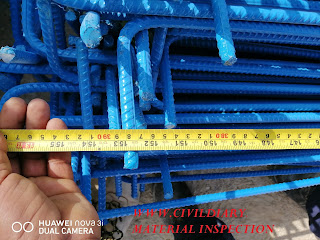 |
| MATERIAL INSPECTION |
- Material Inspection shall be done before cutting, bending of reinforcement. The factory test certificate shall available at the material inspection location with respect to the received delivery order and batch.
- Proper traceability shall be available for reinforcement to ensure the quality of reinforcement.
- Reinforcement shall be Fusion Bonded Reinforcing Steel as per project requirement.
- Reinforcing steel shall be stored over wooden battens to prevent contact with soil and shall be covered to prevent air contact.
- Reinforcing steel storage, cutting, bending, and fixing shall comply with project specifications.
- The civil quality control inspector shall conduct inspections during the pre-placement of concrete and installation of the reinforcement.
- Reinforcing steel shall be accurately placed in accordance with the placement drawings and shall be adequately secured and held in position.
- Reinforcing steel bars, anchor bolts or other steel embedments shall not be used as a means for electrical grounding.
- Welded wire fabric shall be located as shown on IFC drawings.
- Welding of reinforcement shall not be allowed.
- Reinforcing, including tendons and post-tensioning ducts, shall be accurately placed and adequately supported before concrete is placed.
- Lap splices shall be in accordance with placement drawing or project specification or International specification.
- Concrete cover to reinforcement shall be as per International Specification.
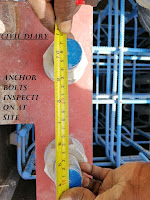 |
| Anchor bolt inspection |
5.3 INSPECTION FOR EMBEDDED ITEMS:
All Embedded items shall be placed as per the approved drawing and project specifications. The Site Engineer shall check the placement and positions of all embedded items against the current construction drawing and shall also be responsible for re-checking the positions of the embedded items to assure no displacement has occurred.
The Quality Control Inspector shall inspect at the Pre-placement inspection for concrete, the embedded items.
Survey checks and reports should be made and submitted together with the Request for Inspection (RFI) prior to the pre-placement of concrete to ensure all elevation and location as per project IFC Drawings.
5.4 PRE-PLACEMENT INSPECTION OF CONCRETE
- Pre-Placement Inspection Request for Concrete Structures shall be submitted by the Site Engineer to the Quality Control Department when the installation of the steel reinforcement, formwork, and embedded items are completed. Upon receiving the RFI, assigned Civil Quality.
- Control Inspector shall initially check the relevant work. If the work is not satisfactory, the Civil Quality Control Inspector shall inform the Site Engineer by notifying the reason for rejecting the work the return the RFI form to the section or Site Engineer for rectification of the defect.
- Wall or Column form should not be closed until the Construction Contractor Civil Quality Control Inspector and Client representative have inspected the steel reinforcement and embedment items.
- Cleaning of the wire nails and bits of wood shall be checked prior to concrete placement.
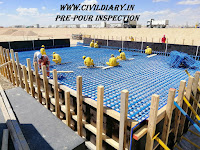 |
| PRE-POUR CONCRETE INSPECTION |
- All field cut ends and damaged rebar shall be coated and repaired with an approved material.
- Joints shall be located as indicated in the drawings.
- The QA/QC Electrical and Mechanical Inspector are also required to inspect to verify items, which affect their trades are completed before the placement of the concrete.
5.5 CONCRETE PRODUCTION/ CONCRETE PLACEMENT CONTROL
- The Site Engineer shall initiate an internal request for inspection and ordering concrete designating the concrete order information, The structure to be concreted, the date and time for concreting and pass a copy of the Request to the Quality Control Department for planning the inspection activities on site.
- After receiving a copy of the Request for Inspection and concrete order, the Civil Quality Control Inspector shall verify the designated areas for concrete placement have been inspected and cleared.
 |
| CONCRETE POURING |
5.6 CONCRETE RECEIVING, SAMPLING, FIELD TESTING, AND PLACEMENT :
CONCRETE RECEIVING -
- The approved third-party field technician shall monitor concrete receiving and obtain a copy of all concrete delivery notes.
- Truck mixing is allowed if the discharge of the concrete cannot be achieved with 90 minutes.
SAMPLING AND FIELD TESTING OF CONCRETE -
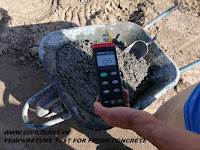 |
| TEMPERATURE TEST FOR FRESH CONCRETE |
Samples of fresh concrete shall normally be obtained from the chute of the truck mixer during discharge.
Concrete samples set of 6 cubes shall be taken for every 50 M3, marked with identification of cubes.
The field tests for slump and concrete temperature shall be performed by the approved third-party field technician on-site to the required testing standards as per the project specifications.
All testing to be done such as temperature, air content, and slump shall be as per the project requirement.
Concrete slump shall be based on design mix and concrete delivered to the site above 32 degrees shall be rejected
CONCRETE PLACEMENT -
- Cleaning of tie wires, nails, bits of wood, and cleaning of wind-blown sand shall be checked by the QC Inspector prior to placing concrete.
- A minimum of two concrete vibrators/pumps shall be on-site for each concrete placement, flexible hoses to be used for concrete placement for walls, Concrete shall be placed in horizontal layers not exceeding 450mm in depth.
- Concrete shall not be dropped freely where reinforcing will cause neither segregation nor where it would fall freely for more than 1 meter.
Civil QC Inspector shall notify the site or section engineer in charge to hold work and implement an immediate correction in case of any unacceptable operations prior to concrete.
- Equipment made of aluminum alloys shall not be used for pump lines, tremies, or chutes used to discharge concrete from a truck mixer.
- Concrete shall not be placed prior to a recorded pre-placement inspection.
- Raking shall not be used for the movement of concrete after placement.
- Vibrators shall not be sued for the movement of concrete inside forms.
- Re-tempering of concrete after placement is prohibited.
- Concrete shall be deposited as near as possible in its final position to avoid segregation due to re-handling or flowing.
- Concrete shall be placed on a clean surface, standing water shall be removed prior to placement of concrete.
5.7 FORM REMOVAL, CONCRETE SURFACE INSPECTION
FORMWORK REMOVAL -
Formwork shall be removed in such a manner as not to damaged the concrete. No forms shall be removed until the concrete has gained sufficient strength to support itself.
Centers and props may be removed when the member being supported has gained sufficient strength to carry itself and the load to be imposed on it with an acceptable factor of safety.
CONCRETE SURFACE INSPECTION -
After removal of the formwork, the Civil Quality Control Inspector shall inspect the concrete surface and promptly notify the Section / Site Engineer of any areas requiring remedial works. And the final acceptance of concrete shall be verified after 28 days strength test of the concrete.
CURING OF CONCRETE -
Water curing shall be continuous until the compressive strength has reached 70% of the specified strength, but not less than 7 days after placement, and shall be done by covering with wet burlap and plasticized sheet.
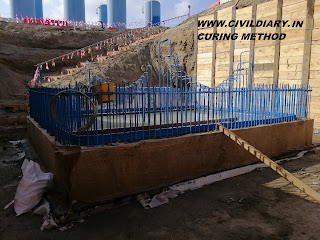 |
| CURING OF CONCRETE |


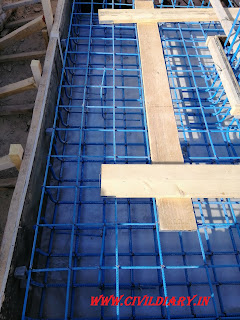


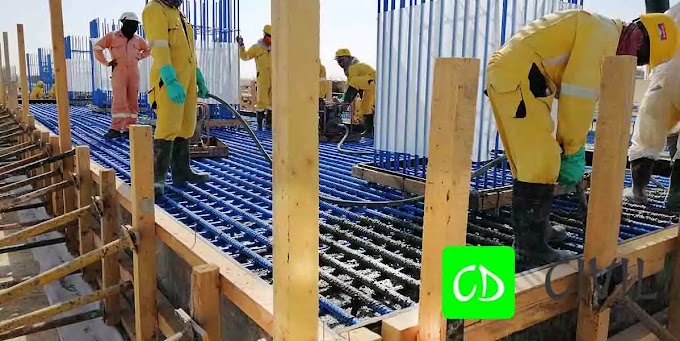

1 Comments
This is very nice and good Information
ReplyDeleteThank you
Friends comment your doubts